In the Moment:
Michael Frye's Landscape Photography Blog
by Michael Frye | Feb 6, 2014 | Vision and Creativity
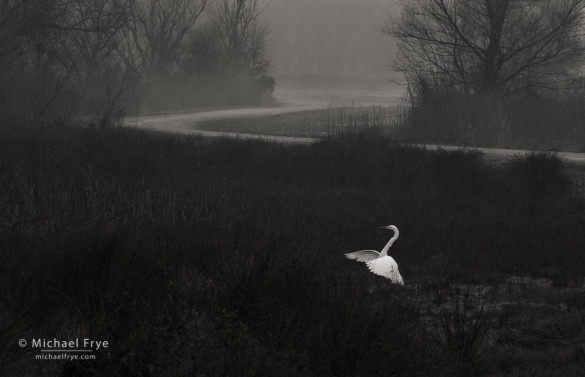
Great egret landing, San Joaquin Valley, CA, USA
This image was a lucky accident. I was standing next to my car along a tour route at one the wildlife refuges in the Central Valley, looking at a large flock of sandhill cranes and Ross’s geese, when I saw this egret flying by. I quickly turned, pressed the autofocus button on the back of the camera, followed the bird, and held the shutter button down as the egret landed.
The photograph languished in my archives for awhile before I processed it. Maybe I didn’t realize its potential right away because it was such a grab shot. But I did finally process it recently, and found several things to like about it.
First, there’s the contrast. Most of the frame is dark, but the two key elements – the bird and the road – are lighter, so they stand out. Any time you can place a light subject against a dark background, and have that subject stand out cleanly and distinctly against its surroundings, you have the potential for a strong image. There’s no sunlight in this photo, so the contrast isn’t created by sun and shade, but by the juxtaposition of a white bird against dark vegetation. But it doesn’t matter how the contrast is created, as long as it’s there. (The same idea also works for dark subjects against light backgrounds. I talk more about both kinds of contrast in this post.)
(more…)
by Michael Frye | Feb 4, 2014 | Yosemite Photo Conditions
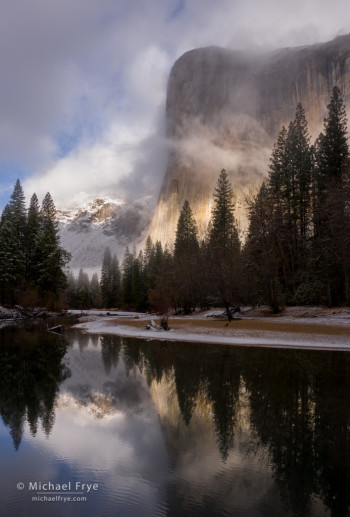
El Capitan and the Merced River during a clearing storm, Friday morning, Yosemite
A clearing storm in Yosemite Valley can be a memorable event, but not all clearing storms are equally photogenic. Some clear gradually, while others finish abruptly and spectacularly. Some storms clear at night, some in the middle of the day, but for photography you’d like the storm to clear just before sunrise or sunset.
Last Thursday, Yosemite Valley got two inches of rain, the first real precipitation in almost two months. Higher elevations got snow, and the temperature dropped enough to give the Valley a slight dusting at the tail end of the storm. The main part of the storm cleared around midday on Thursday – not the best time for photography, though still beautiful. But then showers resumed Thursday night, with the last of them moving through just before sunrise. Perfect timing.
My two brothers were visiting from Washington State, and the three of us rose early, drove up to Yosemite Valley, and headed for one of my favorite spots along the Merced River. The sun broke through the clouds and illuminated El Capitan briefly before the fog thickened and all the cliffs disappeared. But after about ten minutes El Cap re-emerged, the sun broke through, and we were treated to a classic Yosemite clearing storm. The first photograph here is probably my favorite from the morning, but I’ve posted a couple more images below, including a later image from Tunnel View – still a photogenic spot at 10:00 a.m.
(more…)
by Michael Frye | Jan 28, 2014 | Yosemite Photo Conditions
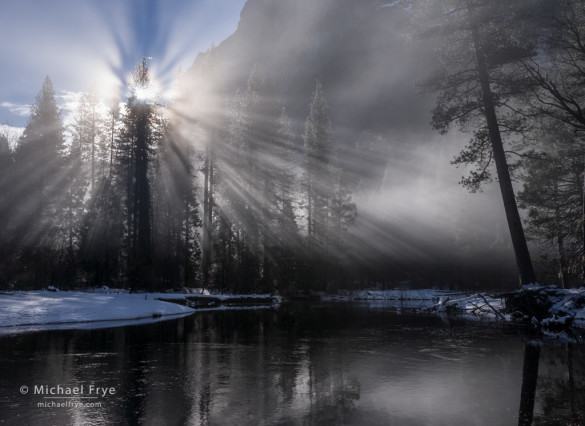
Sunbeams and mist along the Merced River, Yosemite
For many places in California, 2013 was the driest year on record. And so far this winter (our usual rainy season) has brought almost no precipitation. January has brought a procession of sunny days, with temperatures in the 60s or even low 70s at my house at 2700 feet in the Sierra foothills. It’s pleasant weather, but weird, and a little scary, as it seems like it will never rain again.
But finally the forecast is calling for rain and higher-elevation snow this week. It’s not supposed to be a big storm, but we’ll take what we can get. The main pulse of this system is due to arrive Thursday, but showers might linger into Friday or even Saturday. Snow levels are expected to stay at around 7,000 feet on Thursday, but may drop to 4,000 feet on Saturday, so it’s possible, though not likely, that Yosemite Valley could get a dusting of snow.
(more…)
by Michael Frye | Jan 26, 2014 | Light and Weather, Travels and Stories
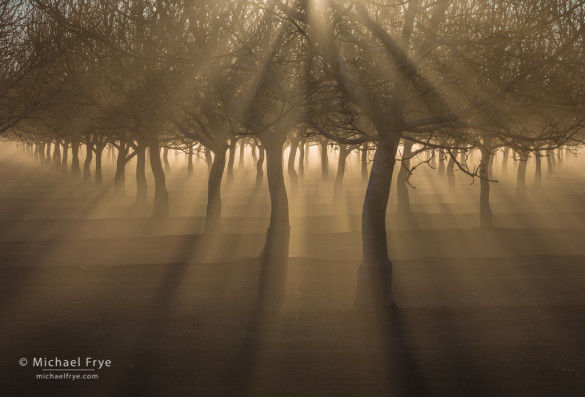
Sunbeams and fog in a Sacramento Valley orchard, California
The last few winters I’ve spent some time in California’s San Joaquin Valley photographing migrating birds – mostly snow geese, Ross’s geese, and sandhill cranes. Last week Claudia and I ventured further north, into the Sacramento Valley (the northern half of California’s Great Central Valley), exploring some of the backroads and wildlife refuges there.
One morning, while driving an obscure little road in the Sacramento Valley, Claudia and I stumbled upon an orchard filled with fog. As far as we could tell there was no other fog within 50 miles, because there’s very little moisture anywhere, but for some reason this one spot had fog – possibly because the trees had been watered recently, creating moisture that condensed in the cool morning air.
Seeing the sunbeams cutting through the mist underneath the trees, I grabbed my camera and tripod, and quickly framed a few compositions, one of which is shown above. Within five minutes the fog had burned off, leaving us with yet another clear, warm, dry January day.
(more…)
by Michael Frye | Jan 19, 2014 | Yosemite Photo Conditions
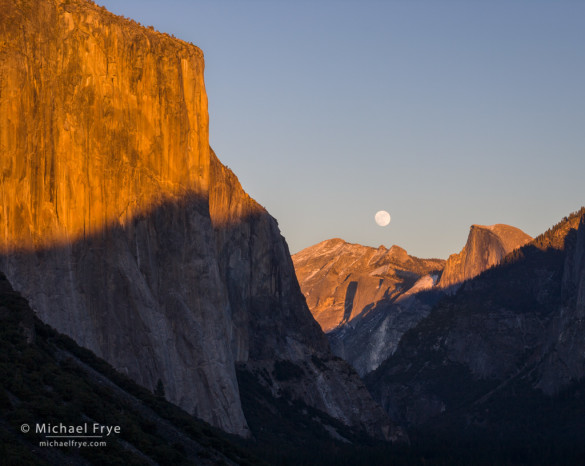
Moonrise from Tunnel View, Yosemite NP, CA, USA
During my Landscapes in the Digital Darkroom workshop last week for The Ansel Adams Gallery we photographed two moonrises, including this one on Tuesday from Tunnel View. The moon appeared right over Cloud’s Rest, between Half Dome and El Capitan, just before sunset – a spectacular sight. I’ve included two versions here: a black-and-white image just as the moon climbed into view (below), and a color version when the moon rose a little higher (above).
(more…)
by Michael Frye | Jan 14, 2014 | Announcements
We had a great response to the PhotoPills giveaway, with nearly 300 people putting their names into the hat. We assigned each person who entered a number, and used a random number generator to select the five winners. And the winners are…
John (email starts with jwtrone)
Mike Lynch
Dk Tanaka
Howard Snyder
Susan Markovic
Congratulations to the winners! You’ll each receive an email shortly from Claudia with a code for downloading a free copy of PhotoPills. And if you didn’t get lucky this time, the app is only $9.99, and well worth the price.
Thanks to all of you who participated, and good luck with your moon photos!
— Michael Frye
by Michael Frye | Jan 12, 2014 | Announcements
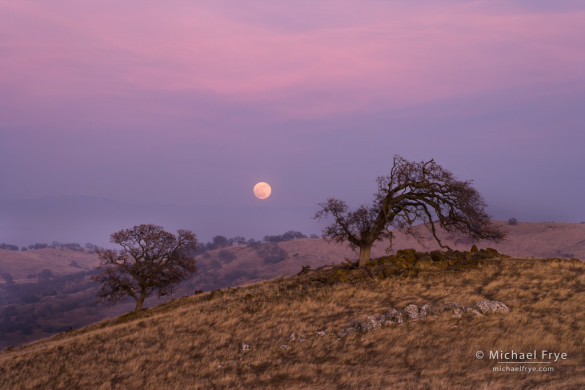
Moonrise, Sierra foothills, Mariposa Country, CA, USA
In my December post Moonstruck I talked about the two best apps for figuring out sun and moon positions: PhotoPills and The Photographer’s Ephemeris.
I’ve relied on The Photographer’s Ephemeris for many years; it’s a great tool. PhotoPills is newer, but as I’ve become more familiar with it I’ve used it more and more. PhotoPills has a couple of very useful extra features, like it’s Augmented Reality mode, which allows you to superimpose the future path of the sun, moon, or other celestial object over a live picture (on your iPhone) of the scene in front of you. Even better, if you want to photograph the sun or moon lined up with a certain object – a building, or a mountain, for example – you can search for the times when that will happen, and see a list of results which includes moon phases, and the days when your desired alignment corresponds with the “magic” hour.
How to Win a Free Copy of PhotoPills:
This app is normally only $9.99, but Rafael Pons at PhotoPills has generously offered to give away five copies of this app to my readers. To have a chance to win, just post a comment below saying you’re interested. There’s one catch: you must own an iPhone or iPod Touch! PhotoPills is only available for the iPhone so far. (A universal app formatted for the iPad is in the works, but not available yet.) You have until midnight tomorrow (Monday, January 13th) Pacific time to post a comment and have a chance to win.
(more…)
by Michael Frye | Jan 9, 2014 | Announcements
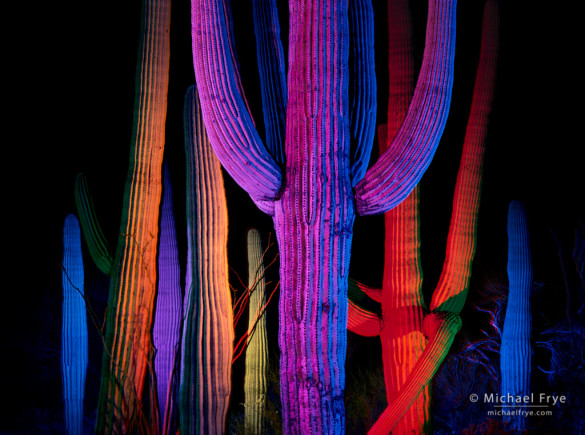
Saguaro cacti at night, Saguaro NP, AZ, USA
Last month Jim Harmer at Improve Photography interviewed me for his popular podcast, and that interview is now live. You can listen to the podcast directly on Jim’s site, or find it in iTunes.
One of the topics we discussed is creative ruts, and how to get out of them. I told the story of how I got out of such a rut in the early ’90s by experimenting with different subjects, techniques, and equipment. I used flash for the first time, which led me to trying flash at night, and eventually to my series of colorful, surreal, nighttime landscapes. The photograph above is perhaps the most recognizable image from that series, but you can see more examples here. (If you click on the thumbnails you’ll find descriptions of how each photograph was made.)
(more…)
by Michael Frye | Jan 8, 2014 | Announcements
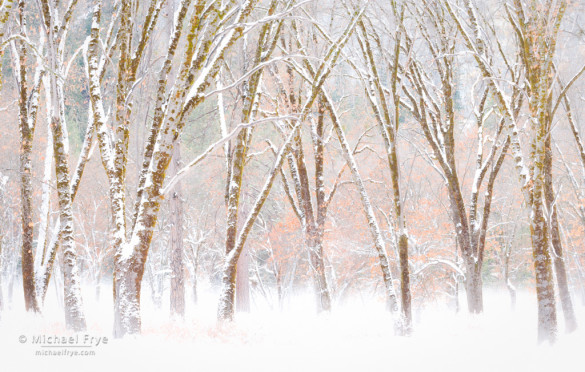
One of my top ten images: Snowy black oaks, late autumn, Yosemite NP, CA, USA
Part of the reason for putting together my top ten photographs of the year was to submit the collection to Jim Goldstein’s blog project – a collection featuring the top images of 2013 from a wide range of photographers. He had a tremendous response this year, with over 300 submissions. If you’re looking for some inspiration, or just want to see some beautiful photography, this is a great list to peruse. I haven’t seen everything yet, so this is by no means a comprehensive selection, but here are some entries that caught my eye and feature some excellent work:
(more…)
by Michael Frye | Jan 4, 2014 | Announcements
The votes are all in and counted, and here are my top ten photographs of 2013!
We had truly an amazing response this year: 396 people looked through my initial selection of 49 images and posted their picks here on the blog, Facebook, Google+, Twitter, and by email. A big thank you to everyone who took the time to look through these photographs and voice your opinions! I also really appreciate all the kind words expressed along with the votes. I wish I could respond to every comment, but please know that I’ve read them all and am very grateful for all your support. And last but not least, many thanks to my wonderful assistant Claudia who tallied all those votes!
To express our gratitude to all of you we’ve decided to give away another print to one of the voters. We assigned each person who voted a number, and used a random number generator to pick the recipient. And the winner is… Judy Heiser! Judy will receive a signed, numbered, matted 16×20 print of her choice from among the 49 original selections. Congratulations Judy!
So here’s the list of the ten images which received the most picks, and the number of votes they each received:
(more…)
















